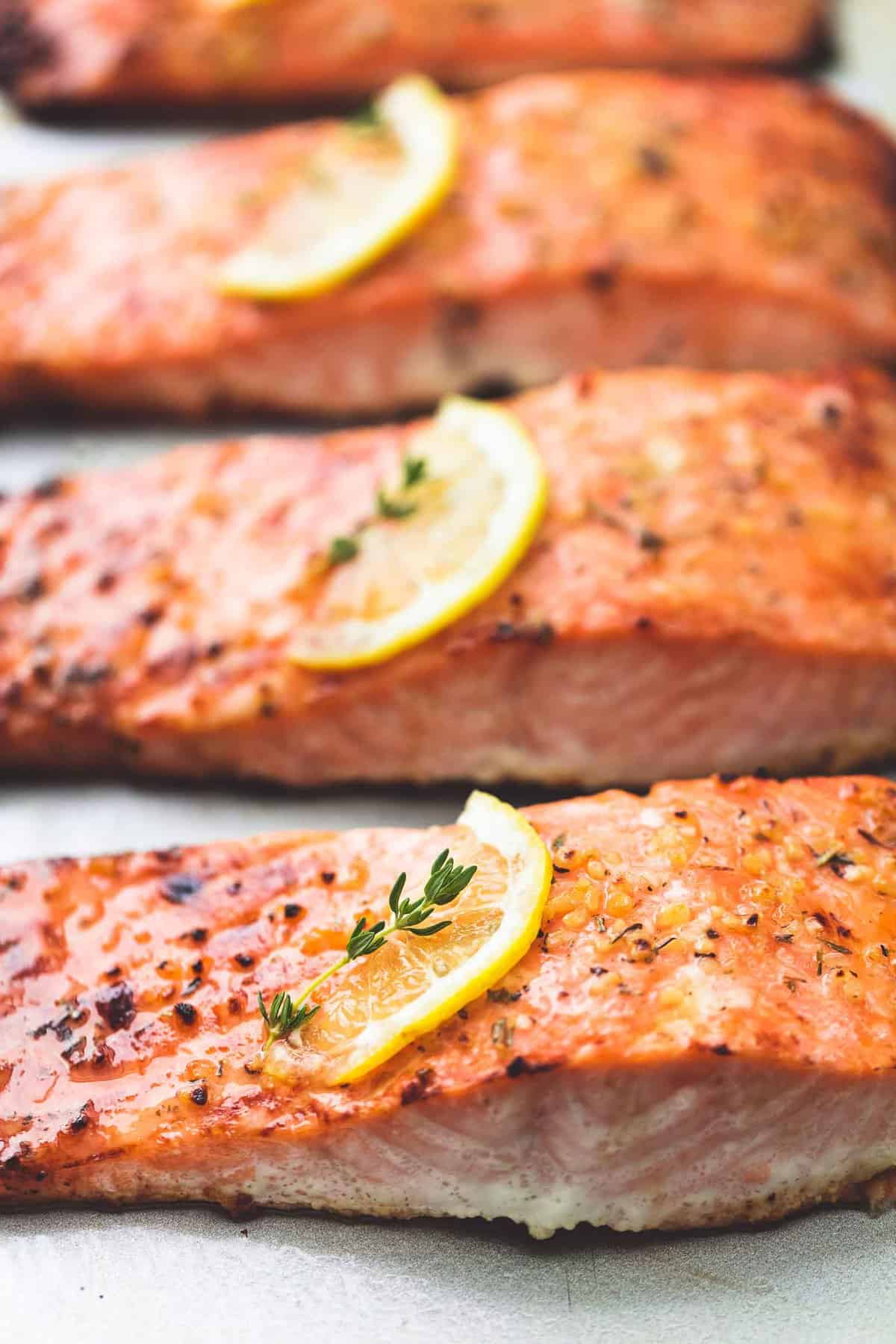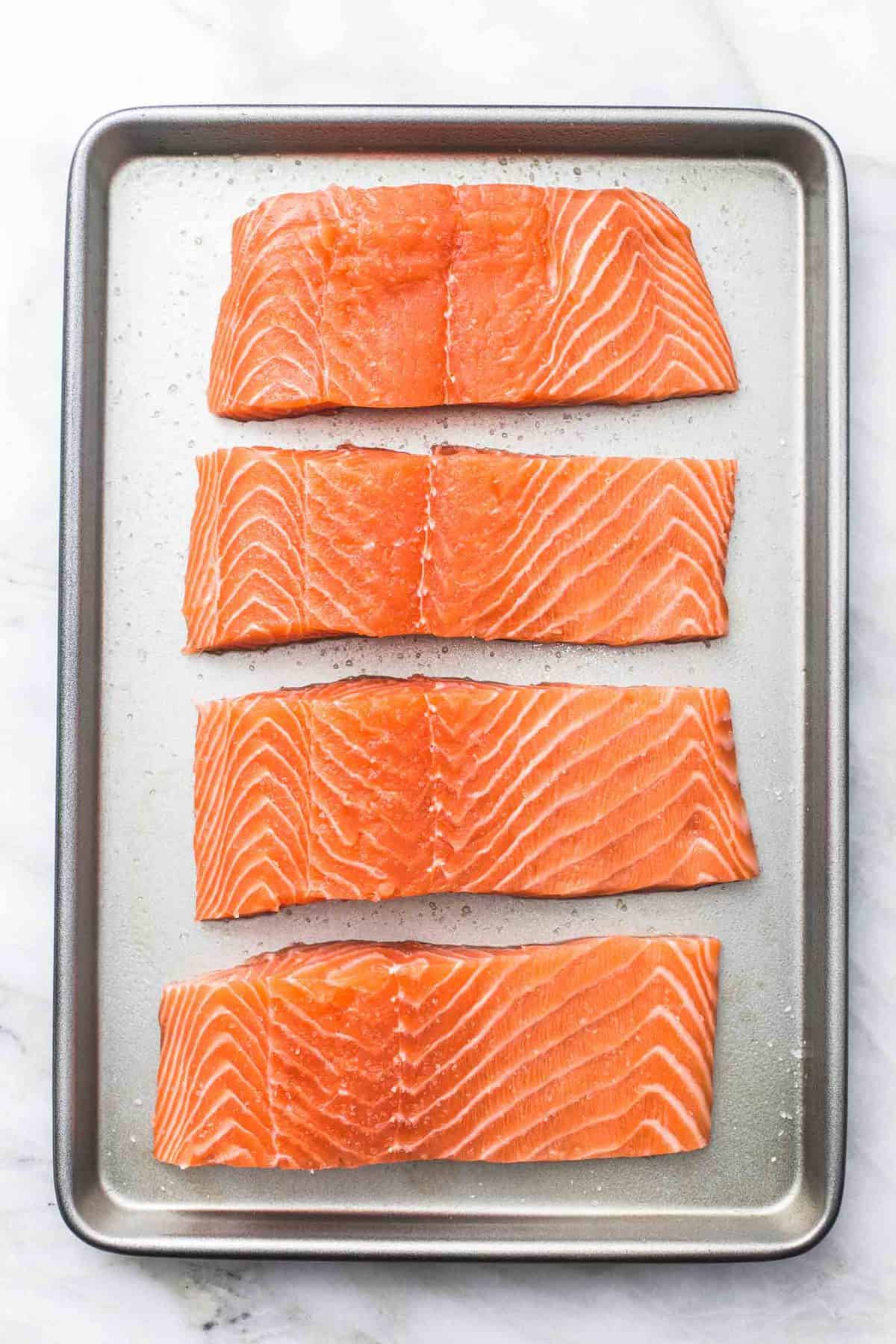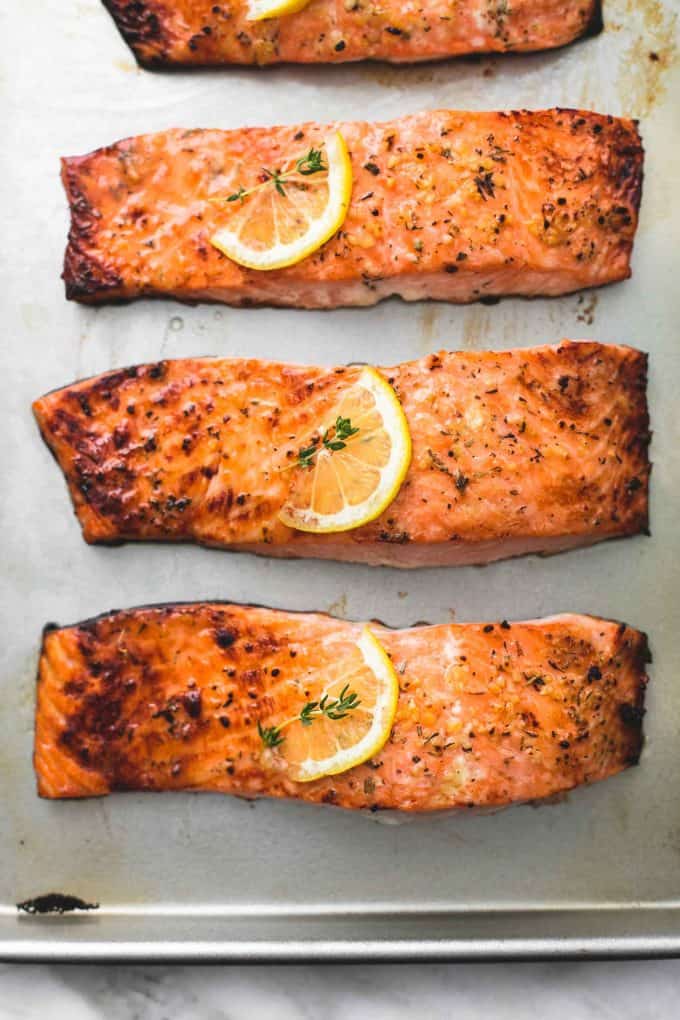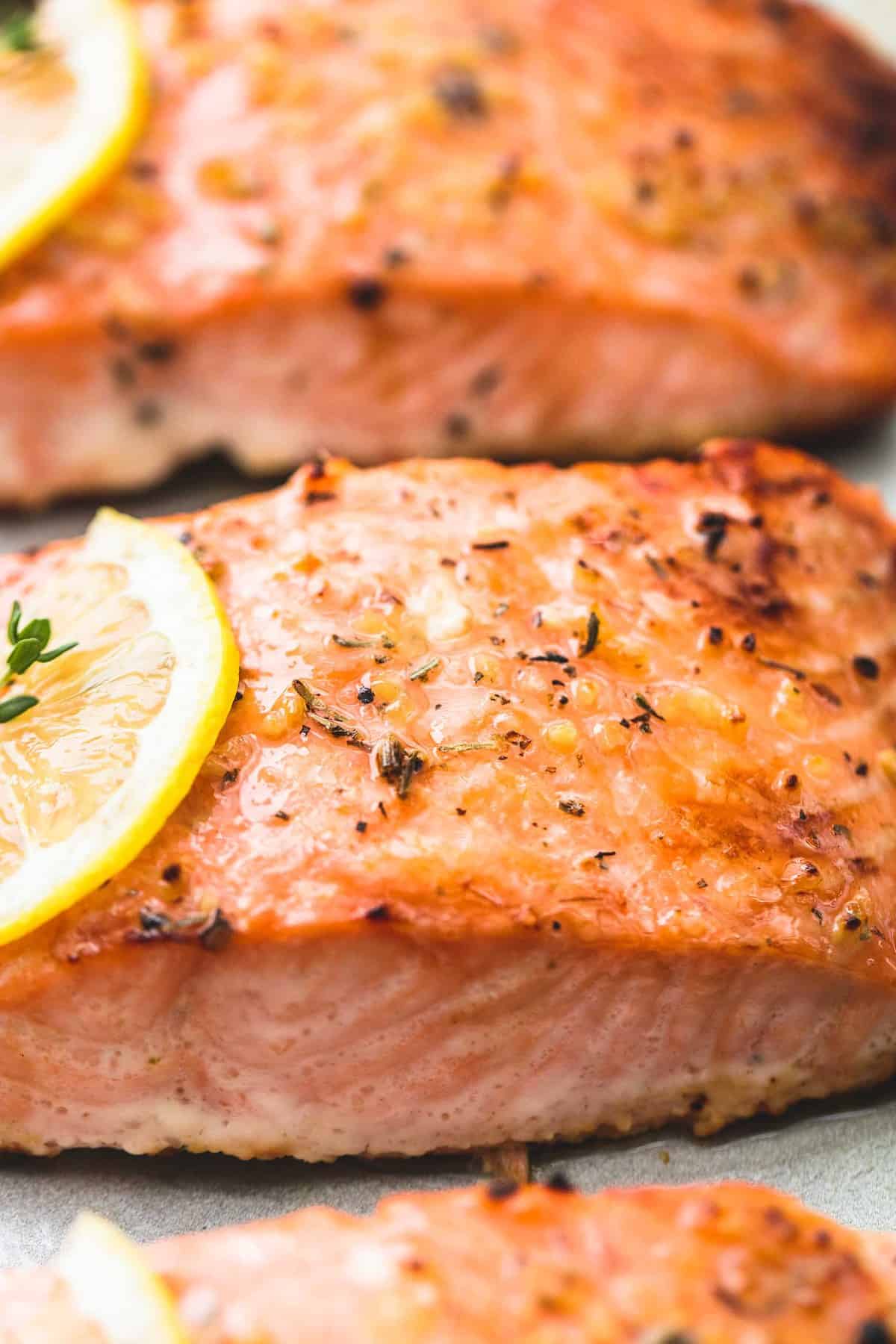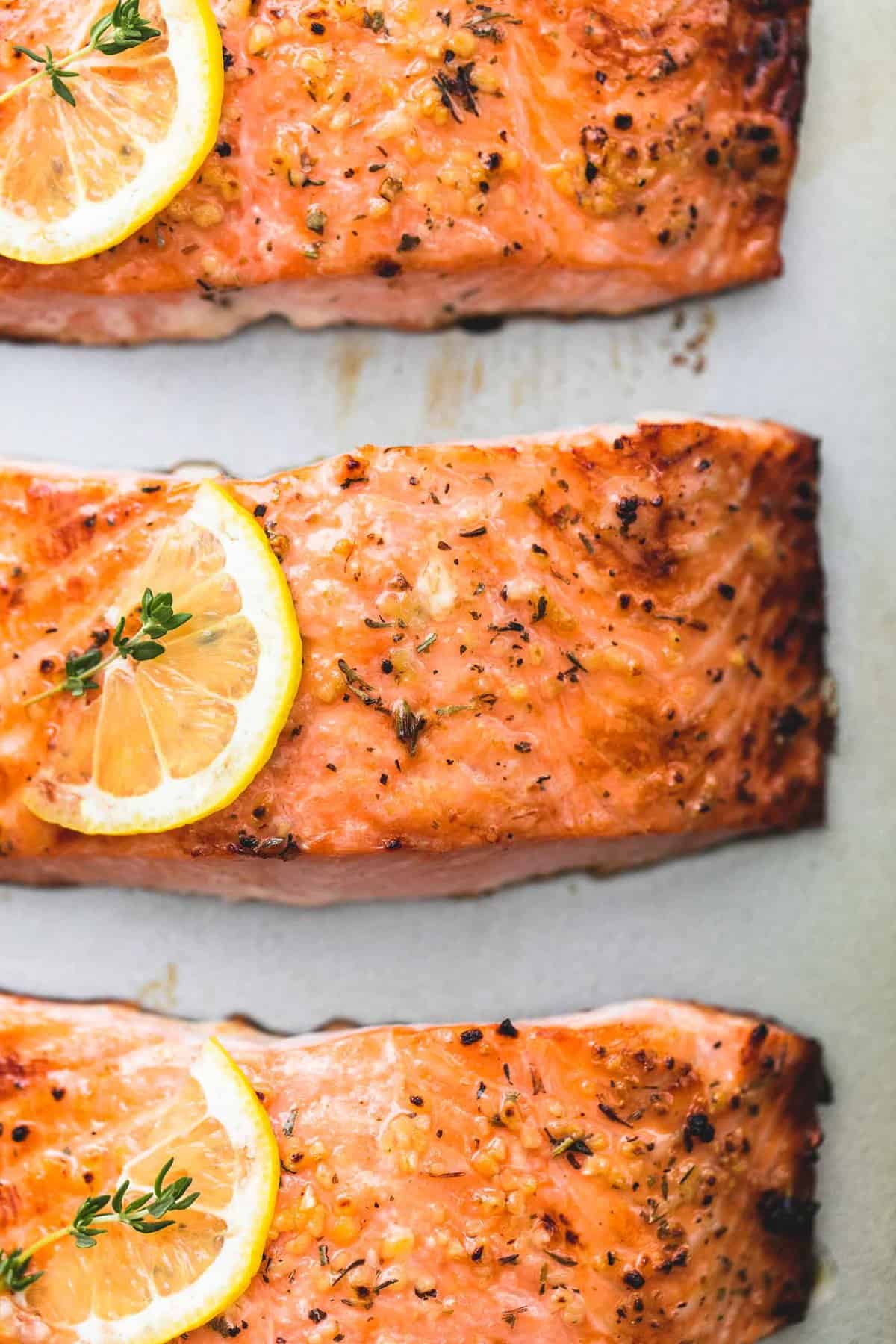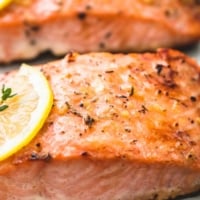Here’s the thing. I really really love salmon. Enough that I’ve said a few times out loud that if I had to choose one type of animal-based protein to live on for the rest of my life, it would be salmon. I make a lot of chicken dishes, and I can put away a thick, juicy steak like it’s nobody’s business, but if it ever comes right down to it I’m choosing salmon. I can’t say I have a lot to say about this salmon, except that it is exactly what I’m calling it: Easy. Healthy. Baked. Well, and Salmon (of course). But there seriously could not be an easier recipe for baking up the most perfect, lemony, garlicky salmon every single time. I have loads of hugely popular salmon recipes here on Creme de la Crumb, from sweet and spicy Thai-inspired, to shrimp-smothered (such as my Baked Thai Pineapple Salmon in Foil and Salmon New Orleans,) and grilled in a foil pack with asparagus, but it is high time I gave you this super simple, straightforward, no-tricks-only-treats Easy Healthy Baked Salmon. You’re welcome.
How to Make this Baked Salmon Recipe
Ingredients You’ll Need
Salmon Fillets – look for fresh salmon fillets that are nice and pink and moist. Alternatively, purchase frozen fillets that are vacuum sealed with no freezer burn. Olive Oil – I use extra virgin, but any kind will work. You can also substitute vegetable oil. Salt – Kosher salt works great; I also love Himalayan pink salt. Cracked Black Pepper – I tend to go overboard but remember to use a little pepper at first and taste before adding more. Minced Garlic – Minced garlic in oil purchased at the store is great or you can mince your own. Italian Herb Seasoning Blend (or Herbs de Provence) – Any well-known brand will do or make your own. Don’t skimp on the aromatic flavors of Italian seasonings on this salmon recipe. Lemon – A medium-size lemon is fine here or purchase a larger one if you love the tangy tartness of extra lemon.
Step By Step Directions
What Are the Five Types of Salmon?
Believe it or not, there are five main kinds of salmon. (Seven total types really, but you’ll really only come across five kinds in the states.) They can be small and weigh around five pounds, or they can grow to be enormous, weighing around 126 pounds! Some kinds of salmon live in freshwater, some live in saltwater, and some live in both, depending on the season. The five main kinds of salmon are all of the Pacific variety.
Sockeye salmon is a red-colored fish and also happens to be lower in fat than other varieties. It’s a popular variety and quite tasty. King or Chinook salmon is very high in fat and super expensive. You’ll probably only find this fish in high-end fish markets or fancy restaurants. It has a delightful texture, or mouthfeel to it. Pink salmon is a very small, pale variety of the fish. This kind of salmon is most often used in the canning process, and what you’ll find when you purchase cans of salmon. Chum salmon is a type that’s most popular for its roe, or eggs. They are the kind of eggs that you see in sushi rolls. I think the name sounds gross, and would probably not buy it on its own but I guess you can’t judge a fish by its name, right? Coho salmon is another popular type of fish and is milder in taste than other types of salmon. It’s that silver salmon you most often see in photos of fishermen holding up a giant salmon for photographers, an “I caught a fish THIS BIG” kind of photos.
Is Salmon Healthy?
Salmon is a great source of animal protein, an almost a perfect source of omega-3s (and what you’ll find in most fish oil capsules), and it has a lot of protein, vitamin B, calcium, potassium, and antioxidants as well. It’s lower in calories and saturated fats than a lot of red meat options, and it has zero carbs, fiber, or sugar. Eating salmon can help lower your cholesterol and makes a great Meatless Monday option. As you may have been able to tell from my various salmon recipes, we eat it quite a bit! (For another great recipe idea, try my Air Fryer Salmon.)
How to Shop for Salmon
Shopping for salmon is easy. Just follow these simple tips:
If you can smell it, make sure it doesn’t smell fishy. Fresh salmon shouldn’t have any kind of fishy smell. Avoid fresh salmon that appears dried out or has brown spots or bruising. The flesh should be vibrantly colored and not anemic or pale looking. If you’re purchasing frozen or pre-packaged salmon, make sure there is a tight seal around the packaging and that it isn’t broken anywhere or open. If you’re not sure, read the label and stay away from anything that says “color-added” or has too many ingredients listed. You can always ask a fishmonger for advice on the various types of salmon if one is available.
The Best Temperature for Baking Salmon
Oven baked salmon on a rimmed baking sheet is cooked all the way through when an internal temperature reaches 110 to 140 degrees in the center of the thickest part of the meat. About four to six minutes per side is usually enough baking or grilling to reach this temperature. Salmon can be served medium-rare to medium well-done.
How to Know When Salmon is Done Baking
If you don’t have a meat thermometer there are a couple ways to know if your salmon is done cooking. As a piece of salmon bakes it turns from red to pink as it cooks. You can check for doneness by cutting into the thickest part of the fish with a knife. It should still be slightly translucent in the center and beginning to flake.
Tips for Perfectly Baked Salmon
Make sure you don’t cook oven baked salmon at a too high or too low of a temperature or it’ll dry out. You can cover the salmon while it cooks to ensure it remains moist. If you keep the salmon skin on, that can also help make a natural barrier between the salmon and the heat source/dish to help keep the moisture in the salmon. Cooking at a gentle, low heat is the best way to bake salmon every time and keeps it from drying out as well.
You only need to cook salmon in the oven about 12-15 minutes. Any more and it will be dry and overdone.
How to Store and Reheat
Storing a piece of salmon is easy. Simply put it in an airtight container or wrap tightly in aluminum foil and put it in the fridge. It will keep for about 3-4 days. To reheat oven baked salmon, warm slow and low and add a splash of water too for added moisture. I also like to reheat the all types of salmon in the oven or a pan on the stove rather than microwaving as microwaving also tends to dry meat out faster when reheating. If you like simple, easy recipes for your main course, then you’ll also want to try my Best Healthy Grilled Chicken, this Instant Pot Balsamic Pork Tenderloin, or my Garlic Lime Shrimp Marinade.
More Delicious Salmon Recipes You’ll Go Crazy for
Think this top-rated Easy Healthy Baked Salmon recipe is good?? Just wait til you try these other super popular salmon dishes!
Sheet Pan Salmon with Asparagus and Potatoes Baked Honey Cilantro Lime Salmon in Foil Grilled Salmon with Mango Salsa Salmon in Creamy Sun Dried Tomato Sauce Baked Thai Pineapple Salmon in Foil
Did you try this Best Easy Healthy Baked Salmon recipe? YAY! Please rate the recipe below!
